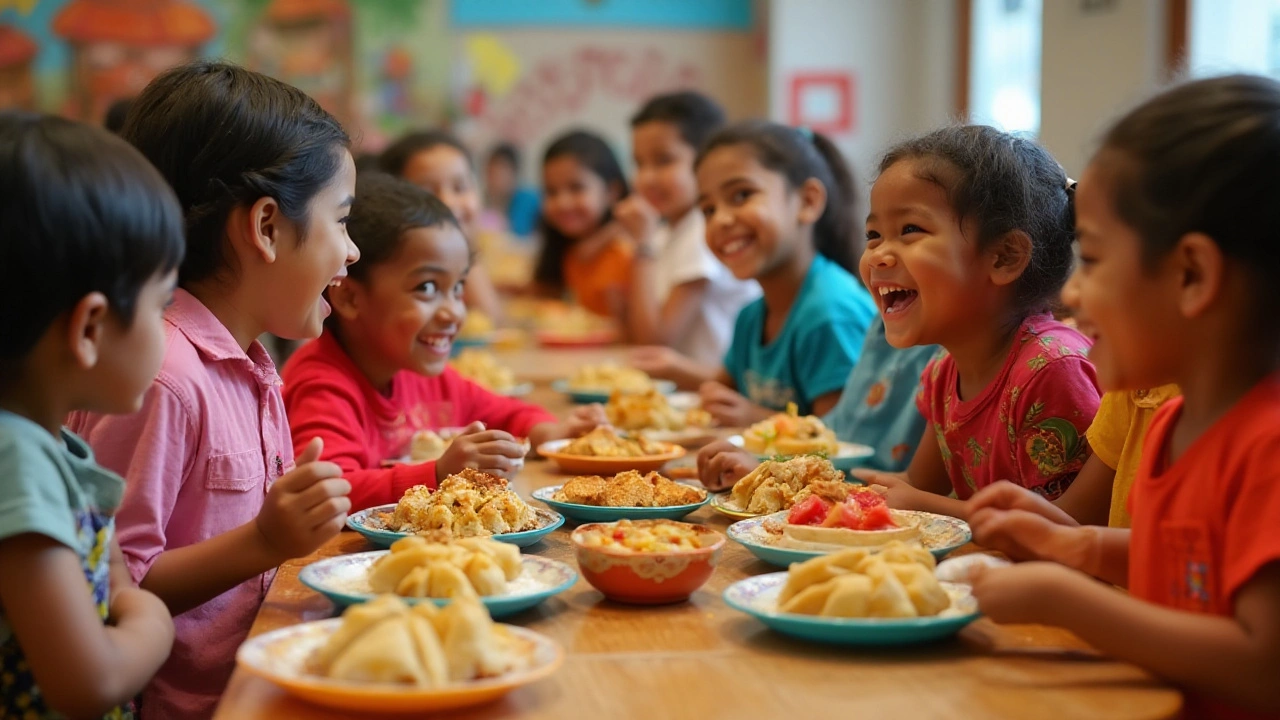
- Created by: Lydia Carmichael
- Completed on: 23 Jan 2025
- Categories: Youth Programs
When the school bell rings at the end of a busy day, kids are often left with appetites as big as the backpacks they carry. Finding the right snacks to satisfy those gloriously growing bellies is a task both practical and delightful. Snacks are more than just fillers; they can be a brilliant way to refuel those little brains and bodies, especially when the right choices are made.
Offering snacks that are both nutritious and appealing can lay the foundation for healthy habits. Think colorful fruits, crunchy veggies, delightful dips, and full-of-goodness nuts. Or perhaps delve into the magic of combining fun with health, creating amusing shapes, or delightful colors to make snacks irresistible. Prepare to inspire and engage as we discover tasty treats that turn after-school hunger into happy memories.
- Why Snacks Matter
- Nutritious and Quick Snack Ideas
- Balancing Fun and Health
- Getting Kids Involved in Snack Preparation
Why Snacks Matter
Snack time might just seem like a stopgap between meals, but when considered thoughtfully, it is far more significant. The food choices we make for children during this period can have a profound impact on their health, mood, and learning potential. According to nutritional experts, after-school snacks are not simply about quelling hunger pangs—they are critical for maintaining a child's energy and cognitive function throughout the day. One key reason snacks hold such importance is due to the growing nutritional needs of children. They require balanced and varied foods to support not only their physical growth but also their brain development. It's estimated that children make up approximately 20% of their daily energy intake from snacks. This shows how parents can use this opportunity to sneak in more vitamins and nutrients naturally lacking in main meals.
Another reason to pay close attention to snack time is the role these mini-meals play in establishing long-term eating habits. While a child is young, they are more open to trying new foods, which means it's the perfect time to introduce them to a variety of healthy options. Over time, these experiences can shape their palate and promote a lifelong appreciation for nutritious foods. Selecting the right after-school snacks also helps to fight the mid-afternoon slump many children experience, characterized by decreased energy and attention. It is during this time that a nutrient-rich snack can provide the much-needed boost to tackle homework or engage in after-school clubs with enthusiasm. It has even been suggested by the American Dietetic Association that a well-balanced snack can heighten performance and concentration.
"Children need constant energy and nutritional input for growth, which makes good nutrition throughout the day essential," says Lisa R. Young, Ph.D., R.D., author of 'The Portion Teller Plan.'
It's also necessary to highlight that the best snacks strike a balance between taste and nutrition, making them appealing and beneficial at the same time. This is why offering a combination of protein, carbohydrates, and healthy fats in snack options is advised. These combinations ensure sustained energy release, keeping kids fuller for longer and preventing sudden spikes and crashes in blood sugar levels. By including a variety of snacks, parents can ensure that different nutritional bases are covered, enhancing not only satisfaction but also delivering the essential macronutrients necessary for healthy growth and development. After-school snacks are not just about nutrition; they are also an opportunity to reinforce positive eating practices and encourage kids to listen to their hunger cues.

Nutritious and Quick Snack Ideas
When kids come home from school, they're often ravenously hungry, and opening a bag of chips might be tempting. But why not choose a more nourishing path instead? Healthy snacks can be just as quick and far more beneficial, providing much-needed vitamins and energy for growing bodies. For instance, try fruits like bananas or apples paired with a dollop of peanut butter. This classic combination offers a delightful mix of sweet and savory, perfect for an energy boost and vital nutrients such as potassium and protein.
Another idea is a fun and colorful veggie platter. Cut up carrots, cucumbers, and bell peppers, and serve them with a tasty hummus dip. Hummus is packed with protein and fiber, making it an excellent choice for curbing hunger pangs. Presentation is key here, and arranging them in playful shapes or patterns can add an element of fun that appeals to kids. Creating snacks that are visually appealing might also encourage hesitant eaters to give veggies a chance.
Grains, too, can transform into quick snacks without losing the health advantage. Consider rice cakes topped with avocado and cherry tomatoes, sprinkled with a pinch of sea salt. These provide healthy fats and a crunchy texture that even the pickiest eaters may enjoy. If you're in the mood to get a bit creative, try crafting homemade trail mix. Mix whole-grain cereal, dried fruits like raisins or cranberries, and unsalted nuts. This combination provides a perfect crunch with a hint of sweetness, allowing kids to fill up without the unnecessary sugars found in commercial snack mixes.
Easy recipes are essential for busy parents who have less than an hour to whip something up. For an effortless option, yogurt parfaits can be both delicious and nutritious. Layer Greek yogurt with a drizzle of honey, granola, and fresh berries. This delightful mix delivers calcium, antioxidants, and fiber; essential nutrients mere cookies can't compete with. Incorporating flavors kids love ensures that they don't miss out on the goodness.
Referring to expert advice, as nutritionist Gina Faulkner once suggested, finding the balance between fun and nutrition doesn't have to be a battle, "It's about integrating playful and imaginative elements into food. If kids see their snacks as fun and rewarding, they're more likely to explore and develop favorable attitudes toward healthy eating."
"Opt for snacks that combine taste, nutrition, and creativity. The key is to make them as part of their exciting culinary journey rather than an obligation," said Faulkner.
There's always room for innovation. By using leftovers or seasonal produce, it's possible to create varied snacks, ensuring kids never tire of the same flavors. With these ideas, you can transform the often dreaded post-school 'I'm hungry!' cry into a time for culinary bonding within the family.

Balancing Fun and Health
Creating after-school snacks that both excite the senses and nourish the body presents a delightful challenge. It's like finding the perfect balance on a colorful seesaw in the world of children's snacks. Many parents strive to make sure that the nutritious aspect doesn't overshadow the fun of eating. A great way to achieve this is by transforming simple ingredients into something extraordinary. Imagine slicing apples and topping them with almond butter while sprinkling a few dark chocolate chips on top. Suddenly, a plain apple becomes an engaging treat, delivering both taste and nutrition in a fun package.
A fantastic snack that decorates the plate and delivers essential nutrients is a yogurt parfait. Start with plain yogurt, which provides probiotics beneficial for gut health. Layer this with crunchy granola and a medley of fresh, colorful berries, bursting with vitamins and antioxidants. The playful texture and vivid colors attract the eyes, making eating an enjoyable adventure. A delightful yogurt parfait marries the notion of fun with health, reinforcing good habits without compromising on taste.
And who can resist a touch of nostalgia with homemade “energy balls”? Packed with oats, peanut butter, and a hint of honey, they remind one of the timeless combination of sweet and savory. Rolling these little delights with eager young hands imparts an extra level of enjoyment to the process. They offer quick energy and fiber, not to mention a sense of achievement in creating something mouthwatering from scratch. As the kids mold the sticky dough, they engage with food in a way that teaches the value of healthy eating.
Including children in the preparation process helps further distinguish the line between fun and health. Let them choose fruits in the store or decide on their favorite healthy toppings. Such involvement piques curiosity and encourages them to develop a more sophisticated palate. Kids who participate in snack-making are more likely to consume what they created, diving into the meal with enthusiasm. As Jamie Oliver once famously said,
"Kids need to be engaged and involved in food from the ground up, from seed to plate."His philosophy underscores the importance of making food exciting, turning mundane ingredients into stories kids can tell.
There's also room for a pinch of creativity with snacks often overlooked, like the versatile rice cake. Even this simple food can be an exciting canvas. Start with a plain rice cake, spreading a layer of hummus, and adorning with sliced cucumbers, cherry tomatoes, and perhaps a sprinkle of feta cheese. This snack not only looks inviting but also provides a blend of proteins, healthy fats, and carbohydrates, supporting sustained energy levels.
For those looking to explore statistics on kids’ snack preferences, a recent survey highlights that nearly 75% of children prefer snacks that are visually appealing, with colorful ingredients making them more likely to eat their vegetables. These insights remind us that presentation can play an equally important role in promoting healthy snacking habits. A fun snack isn't just a temporary indulgence; it's a pathway to cultivating a lifelong love for healthy eating, wrapped inside a story that invites children to relish every bite.

Getting Kids Involved in Snack Preparation
Inviting kids into the kitchen doesn't just lighten your workload; it's also a fantastic way to teach them valuable life skills and get them genuinely excited about what they eat. Children are naturally curious, and involving them in making their own after-school snacks can be both educational and entertaining. They learn about nutrition, develop a sense of responsibility, and are more likely to try new foods if they have had a hand in preparing them. The activity can also serve as an ideal way to bond with your children, creating warm memories alongside delicious treats. The key is to make the experience enjoyable and age-appropriate, giving them safe, manageable tasks like washing veggies, spreading toppings, or mixing ingredients.
According to a study conducted by the University of Alberta, children who help prepare their meals are more likely to make healthier dietary choices as they grow up. Why not turn this into a fun weekend project and spend some time planning a week's worth of snacks together? This collaborative approach can help children understand the importance of nutrition while also giving them a sense of accomplishment. Start with simple recipes and gradually introduce more complex ones as they become more comfortable and proficient in kitchen tasks. You might even inspire a budding chef!
"Involvement in meal preparation is associated with better dietary patterns in youth, which is an important component of chronic disease prevention," notes researcher Dr. Yen Li Chu from the University of Alberta.
To make the experience smoother, consider setting up a dedicated kitchen toolkit for your little chefs. A set of child-safe utensils, colorful chopping boards, and aprons can make the preparation process exciting. Organize the ingredients beforehand and demonstrate the steps methodically, ensuring that safety is always a priority. Praise their efforts and creativity, reinforcing their enthusiasm for future culinary adventures. With encouragement and practice, children may even start to develop their own snack ideas, providing you with inspiration and input for new family favorites.
Let's explore a few simple snack recipes that allow children to use their hands and minds creatively. Try making fruit kebabs using skewers and a selection of fresh fruits or crafting veggies and hummus boats with celery sticks and cucumber slices. Another fun option could be topping rice cakes with peanut butter and fresh berry 'jewels.' The possibilities are endless when inspiration and imagination come together in the kitchen. By involving kids in snack preparation, you're not just whipping up a tasty treat; you're also cooking up a recipe for lifelong healthy eating habits!